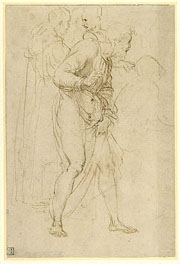| |

Pope Julius II and the Stanza
della Segnatura
Pope Julius II (1443-1513), who reigned from 1503 to 1513,
successfully combined political authority and prosperity
to make grandiose artistic commissions. With the same
determination displayed in his political and ecclesiastical
successes, Julius II embarked on a grand scheme to redevelop
the Vatican Palace and, in particular, the papal apartments.
He decided to reconstruct his living quarters and redecorate
the suite of rooms also known as the stanza. These rooms
were a crucial part of the building and included a space
to which he dedicated special attention - his personal
library.
Soon
after Julius's tenure, the Biblioteca Julia was transformed
according to the whims of his successors, first into a
music room and subsequently into the Stanza della Segnatura,
where the supreme tribunal of the Curia convened. The
Curia is the body of congregations, tribunals, and offices
through which the pope governs.
|
 |

Raphael. Studies for the Disputa, 1509-1511, pen
and brown ink. Collection: J. Paul Getty Museum
|
 |
Raphael
Emerges
Julius II invited a team of artists to join forces on
his grand decorative enterprises in the papal palace.
The circumstances in which Raphael emerged as the leading
painter of the stanza are not entirely clear.
What is certain is that he found in Julius a patron
with vision and determination who helped support Raphael's
explosion of genius. When Raphael reached Rome from
Florence around 1508, he had enough experience in fresco
painting as an assistant to Perugino and Pinturicchio
to ensure a thorough knowledge of mural technique and
its limitations. The great works by Leonardo and Fra
Bartolomeo that he saw in Florence influenced his style
and technique. In the Vatican, he began work in Julius'
library, which had been assigned to the Lombard painter
Sodoma and his German collaborator Johannes Rysch. Having
perceived the younger master's innate talent, Julius
apparently removed the other artists involved and engaged
Raphael to continue the design single-handedly. Raphael
then faced his first great challenge- to formulate a
series of varied, yet unified, monumental frescoes and
transform them into one overwhelming spectacle.
Iconography
The Stanza della Segnatura is decorated with
the icons traditionally associated with libraries. Each
wall is dedicated to a particular aspect of knowledge-Philosophy,
Poetry, Jurisprudence, and Theology. Each of these abstract
notions is personified on the ceiling by the image of
a beautiful woman. Below them are large scenes that
relate to each icon. Under the image of Philosophy are
painted great ancient thinkers gathered on a podium
with their followers in the School of Athens. Beneath
Poetry are famous poets and literary figures assembled
on Mount Parnassus. The establishment of significant
codes of law is depicted beneath Jurisprudence. Under
Theology is the Disputa, representing a theological
discussion of the Eucharist, one of the seven sacraments
and central mysteries of the Catholic faith.
The
Disputa
The
Disputa is thought to be the first of the stanza's
frescos to be painted and a model for those that followed.
The fresco is divided into three distinct zones. The
crowning golden vault is reserved for the Heavens where
God is attended by angels. Below, Christ with the Virgin
Mary and St. John the Baptist are seated on a cloudbank,
slightly removed from the other biblical figures. Theologians,
bishops and philosophers reacting to the Host's presence
and meaning occupy the earthly level, which is also
the viewer's. While this level is full of animation
and commotion, God reigns above in an aura of peace
and serenity. Julius II probably planned the Disputa's
main elements with the help of one or more literary
advisers, yet the true mind behind the resulting composition
was undoubtedly Raphael's.
|
 |
